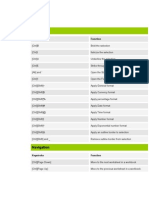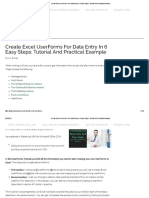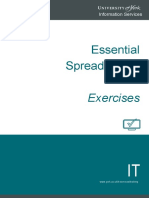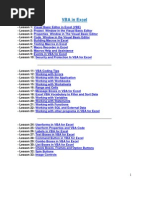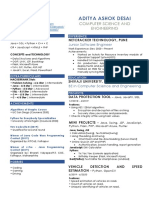Excel Quick Reference
Uploaded by
salcedopozasExcel Quick Reference
Uploaded by
salcedopozasMicrosoft®
Excel Quick Reference
Free Cheat Sheets
Basic Skills Visit ref.customguide.com
The Excel Program Screen Keyboard Shortcuts
General
Quick Access Toolbar Title Bar Formula Bar Close Button
Open a workbook ................ Ctrl + O
Create a new workbook ....... Ctrl + N
File Tab Save a workbook ................. Ctrl + S
Ribbon Print a workbook ................. Ctrl + P
Close a workbook ................ Ctrl + W
Name Help .................................... F1
Box
Activate Tell Me field............ Alt + Q
Active Cell Spell check ......................... F7
Columns
Calculate worksheets .......... F9
Create absolute reference ... F4
Scroll Bars
Rows Navigation
Move between cells ............. ↑, ↓, ←, →
Right one cell ...................... Tab
Left one cell ........................ Shift + Tab
Down one cell ..................... Enter
Up one cell .......................... Shift + Enter
Worksheet Tab Views Zoom Down one screen ................ Page Down
Slider To first cell of active row ...... Home
Enable End mode ................ End
Getting Started To cell A1............................ Ctrl + Home
To last cell........................... Ctrl + End
Create a Workbook: Click the File Select an Entire Worksheet: Click the
tab and select New or press Ctrl + Select All button where the Editing
N. Double-click a workbook. column and row headings meet.
Cut ..................................... Ctrl + X
Open a Workbook: Click the File tab Select Non-Adjacent Cells: Click the Copy................................... Ctrl + C
and select Open or press Ctrl + O. first cell or cell range, hold down the
Paste .................................. Ctrl + V
Select a recent file or navigate to the Ctrl key, and select any non-adjacent
location where the file is saved. cell or cell range. Undo .................................. Ctrl + Z
Redo ................................... Ctrl + Y
Preview and Print a Workbook: Click Cell Address: Cells are referenced by
the coordinates made from their Find .................................... Ctrl + F
the File tab and select Print.
column letter and row number, such Replace .............................. Ctrl + H
Undo: Click the Undo button on as cell A1, B2, etc. Edit active cell ..................... F2
the Quick Access Toolbar.
Clear cell contents............... Delete
Redo or Repeat: Click the Redo
button on the Quick Access Toolbar. Formatting
The button turns to Repeat once Jump to a Cell: Click in the Name
everything has been re-done. Box, type the cell address you want Bold .................................... Ctrl + B
to go to, and press Enter. Italics .................................. Ctrl + I
Use Zoom: Click and drag the zoom
Change Views: Click a View button in Underline ............................ Ctrl + U
slider to the left or right.
the status bar. Or, click the View tab Open Format Cells Ctrl + Shift
Select a Cell: Click a cell or use the and select a view. dialog box ........................... + F
keyboard arrow keys to select it. Select All............................. Ctrl + A
Recover an Unsaved Workbook:
Select a Cell Range: Click and drag Restart Excel. If a workbook can be Select entire row ................. Shift + Space
to select a range of cells. Or, press recovered, it will appear in the Select entire column ............ Ctrl + Space
and hold down the Shift key while Document Recovery pane. Or, click Hide selected rows .............. Ctrl + 9
using the arrow keys to move the the File tab, click Recover unsaved
selection to the last cell of the range. workbooks to open the pane, and Hide selected columns......... Ctrl + 0
select a workbook from the pane.
© 2020 CustomGuide, Inc.
Click the topic links for free lessons!
Contact Us: sales@customguide.com
Edit a Workbook Basic Formatting Insert Objects
Edit a Cell’s Contents: Select a cell and click in Format Text: Use the commands in the Font Complete a Series Using AutoFill: Select the
the Formula Bar or double-click the cell. Edit group on the Home tab or click the dialog box cells that define the pattern, i.e. a series of
the cell’s contents and press Enter. launcher in the Font group to open the dialog months or years. Click and drag the fill handle
box. to adjacent blank cells to complete the series.
Clear a Cell’s Contents: Select the cell(s) and
press the Delete key. Or, click the Clear Format Values: Use the commands in the
button on the Home tab and select Clear Number group on the Home tab or click the
Contents. dialog box launcher in the Number group to Insert an Image: Click the Insert tab on the
open the Format Cells dialog box. ribbon, click either the Pictures or Online
Cut or Copy Data: Select cell(s) and click the Pictures button in the Illustrations group,
Cut or Copy button on the Home tab. Wrap Text in a Cell: Select the cell(s) that select the image you want to insert, and click
contain text you want to wrap and click the Insert.
Paste Data: Select the cell where you want to Wrap Text button on the Home tab.
paste the data and click the Paste button in Insert a Shape: Click the Insert tab on the
the Clipboard group on the Home tab. Merge Cells: Select the cells you want to ribbon, click the Shapes button in the
merge. Click the Merge & Center button Illustrations group, and select the shape you
Preview an Item Before Pasting: Place the list arrow on the Home tab and select a merge wish to insert.
insertion point where you want to paste, click option.
the Paste button list arrow in the Clipboard Hyperlink Text or Images: Select the text or
group on the Home tab, and hold the mouse Cell Borders and Shading: Select the cell(s) graphic you want to use as a hyperlink. Click
over a paste option to preview. you want to format. Click the Borders the Insert tab, then click the Link button.
button and/or the Fill Color button and Choose a type of hyperlink in the left pane of
Paste Special: Select the destination cell(s), select an option to apply to the selected cell. the Insert Hyperlink dialog box. Fill in the
click the Paste button list arrow in the necessary informational fields in the right
Clipboard group on the Home tab, and select Copy Formatting with the Format Painter: pane, then click OK.
Paste Special. Select an option and click OK. Select the cell(s) with the formatting you want
to copy. Click the Format Painter button in Modify Object Properties and Alternative Text:
Move or Copy Cells Using Drag and Drop: the Clipboard group on the Home tab. Then, Right-click an object. Select Edit Alt Text in
Select the cell(s) you want to move or copy, select the cell(s) you want to apply the copied the menu and make the necessary
position the pointer over any border of the formatting to. modifications under the Properties and Alt
selected cell(s), then drag to the destination Text headings.
cells. To copy, hold down the Ctrl key before Adjust Column Width or Row Height: Click and
starting to drag. drag the right border of the column header or
View and Manage Worksheets
the bottom border of the row header. Double-
Find and Replace Text: Click the Find & click the border to AutoFit the column or row Insert a New Worksheet: Click the Insert
Select button, select Replace. Type the text according to its contents. Worksheet button next to the sheet tabs
you want to find in the Find what box. Type the below the active sheet. Or, press Shift + F11.
replacement text in the Replace with box. Click Basic Formulas
the Replace All or Replace button. Delete a Worksheet: Right-click the sheet tab
Enter a Formula: Select the cell where you and select Delete from the menu.
Check Spelling: Click the Review tab and click want to insert the formula. Type = and enter
the Spelling button. For each result, select the formula using values, cell references, Hide a Worksheet: Right-click the sheet tab
a suggestion and click the Change/Change operators, and functions. Press Enter. and select Hide from the menu.
All button. Or, click the Ignore/Ignore All
button. Insert a Function: Select the cell where you Rename a Worksheet: Double-click the sheet
want to enter the function and click the Insert tab, enter a new name for the worksheet, and
Insert a Column or Row: Right-click to the right Function button next to the formula bar. press Enter.
of the column or below the row you want to
insert. Select Insert in the menu, or click the Reference a Cell in a Formula: Type the cell Change a Worksheet’s Tab Color: Right-click
Insert button on the Home tab. reference (for example, B5) in the formula or the sheet tab, select Tab Color, and choose
click the cell you want to reference. the color you want to apply.
Delete a Column or Row: Select the row or
column heading(s) you want to remove. Right- SUM Function: Click the cell where you want to Move or Copy a Worksheet: Click and drag a
click and select Delete from the contextual insert the total and click the Sum button in worksheet tab left or right to move it to a new
menu, or click the Delete button in the Cells the Editing group on the Home tab. Enter the location. Hold down the Ctrl key while clicking
group on the Home tab. cells you want to total, and press Enter. and dragging to copy the worksheet.
Hide Rows or Columns: Select the rows or MIN and MAX Functions: Click the cell where Switch Between Excel Windows: Click the
columns you want to hide, click the Format you want to place a minimum or maximum View tab, click the Switch Windows
button on the Home tab, select Hide & value for a given range. Click the Sum button, and select the window you want to
Unhide, and select Hide Rows or Hide button list arrow on the Home tab and select make active.
Columns. either Min or Max. Enter the cell range you
want to reference, and press Enter. Freeze Panes: Activate the cell where you
Basic Formatting want to freeze the window, click the View tab
COUNT Function: Click the cell where you on the ribbon, click the Freeze Panes
Change Cell Alignment: Select the cell(s) you want to place a count of the number of cells in button in the Window group, and select an
want to align and click a vertical alignment a range that contain numbers. Click the Sum option from the list.
, , button or a horizontal alignment button list arrow on the Home tab and select
, , button in the Alignment group on the Count Numbers. Enter the cell range you Select a Print Area: Select the cell range you
Home tab. want to reference, and press Enter. want to print, click the Page Layout tab on
the ribbon, click the Print Area button, and
select Set Print Area.
© 2020 CustomGuide, Inc.
Click the topic links for free lessons!
Contact Us: sales@customguide.com
Microsoft®
Excel Quick Reference
Intermediate Skills Free Cheat Sheets
Visit ref.customguide.com
Chart Elements Chart Options
Chart Chart Types
Chart Title Elements
Column: Used to compare
different values vertically side-by-
Chart side. Each value is represented in
Styles the chart by a vertical bar.
Data Line: Used to illustrate trends
Bar Chart over time (days, months, years).
Filters Each value is plotted as a point
on the chart and values are
connected by a line.
Chart Pie: Useful for showing values as
Area a percentage of a whole when all
the values add up to 100%. The
values for each item are
represented by different colors.
Gridline
Bar: Similar to column charts,
except they display information in
horizontal bars rather than in
Axis vertical columns.
Titles
Area: Similar to line charts,
except the areas beneath the
Legend
lines are filled with color.
XY (Scatter): Used to plot
Charts Charts clusters of values using single
points. Multiple items can be
Create a Chart: Select the cell range that contains Insert a Sparkline: Select the cells you want to plotted by using different colored
the data you want to chart. Click the Insert tab on summarize. Click the Insert tab and select the points or different point symbols.
the ribbon. Click a chart type button in the Charts sparkline you want to insert. In the Location Range
group and select the chart you want to insert. field, enter the cell or cell range to place the Stock: Effective for reporting the
sparkline and click OK. fluctuation of stock prices, such
Move or Resize a Chart: Select the chart. Place as the high, low, and closing
the cursor over the chart’s border and, with the 4- Create a Dual Axis Chart: Select the cell range you points for a certain day.
headed arrow showing, click and drag to move want to chart, click the Insert tab, click the
it. Or, click and drag a sizing handle to resize it. Combo button, and select a combo chart type. Surface: Useful for finding
optimum combinations between
Change the Chart Type: Select the chart and click two sets of data. Colors and
Print and Distribute patterns indicate values that are
the Design tab. Click the Change Chart Type
button and select a different chart. Set the Page Size: Click the Page Layout tab. in the same range.
Click the Size button and select a page size.
Filter a Chart: With the chart you want to filter Additional Chart Elements
selected, click the Filter button next to it. Set the Print Area: Select the cell range you want
Deselect the items you want to hide from the chart to print. Click the Page Layout tab, click the Print Data Labels: Display values from the cells
view and click the Apply button. Area button, and select Set Print Area. of the worksheet on the plot area of the
chart.
Position a Chart’s Legend: Select the chart, click Print Titles, Gridlines, and Headings: Click the
the Chart Elements button, click the Legend Page Layout tab. Click the Print Titles button Data Table: A table added next to the
button, and select a position for the legend. and set which items you wish to print. chart that shows the worksheet data the
chart is illustrating.
Show or Hide Chart Elements: Select the chart Add a Header or Footer: Click the Insert tab and
and click the Chart Elements button. Then, click the Header & Footer button. Complete the Error Bars: Help you quickly identify
use the check boxes to show or hide each header and footer fields. standard deviations and error margins.
element.
Adjust Margins and Orientation: Click the Page Trendline: Identifies the trend of the
Insert a Trendline: Select the chart where you Layout tab. Click the Margins button to select current data, not actual values. Can also
want to add a trendline. Click the Design tab on from a list of common page margins. Click the identify forecasts for future data.
the ribbon and click the Add Chart Element Orientation button to choose Portrait or
button. Select Trendline from the menu. Landscape orientation.
2020 CustomGuide, Inc.
Click the topic links for free lessons!
Contact Us: sales@customguide.com
Intermediate Formulas Manage Data Tables
Absolute References: Absolute references Export Data: Click the File tab. At the left, Remove Duplicate Values: Click any cell in the
always refer to the same cell, even if the select Export and click Change File Type. table and click the Data tab on the ribbon.
formula is moved. In the formula bar, add dollar Select the file type you want to export the data Click the Remove Duplicates button.
signs ($) to the reference you want to remain to and click Save As. Select which columns you want to check for
absolute (for example, $A$1 makes the duplicates and click OK.
column and row remain constant). Import Data: Click the Data tab on the ribbon
and click the Get Data button. Select the Insert a Slicer: With any cell in the table
Name a Cell or Range: Select the cell(s), click category and data type, and then the file you selected, click the Design tab on the ribbon.
the Name box in the Formula bar, type a name want to import. Click Import, verify the Click the Insert Slicer button. Select the
for the cell or range, and press Enter. Names preview, and then click the Load button. columns you want to use as slicers and click
can be used in formulas instead of cell OK.
addresses, for example: =B4*Rate. Use the Quick Analysis Tools: Select the cell
range you want to summarize. Click the Quick Table Style Options: Click any cell in the table.
Reference Other Worksheets: To reference Analysis button that appears. Select the Click the Design tab on the ribbon and select
another worksheet in a formula, add an analysis tool you want to use. Choose from an option in the Table Style Options group.
exclamation point ‘!’ after the sheet name in formatting, charts, totals, tables, or sparklines.
the formula, for example: Intermediate Formatting
=FebruarySales!B4. Outline and Subtotal: Click the Data tab on the
ribbon and click the Subtotal button. Use Apply Conditional Formatting: Select the cells
Reference Other Workbooks: To reference the dialog box to define which column you want you want to format. On the Home tab, click the
another workbook in a formula, add brackets to subtotal and the calculation you want to use. Conditional Formatting button. Select a
‘[ ]’ around the file name in the formula, for Click OK. conditional formatting category and then the
example: rule you want to use. Specify the format to
=[FebruarySales.xlsx]Sheet1!$B$4. Use Flash Fill: Click in the cell to the right of the
apply and click OK.
cell(s) where you want to extract or combine
Order of Operations: When calculating a data. Start typing the data in the column. When Apply Cell Styles: Select the cell(s) you want to
formula, Excel performs operations in the a pattern is recognized, Excel predicts the format. On the Home tab, click the Cell Styles
following order: Parentheses, Exponents, remaining values for the column. Press Enter button and select a style from the menu.
Multiplication and Division, and finally Addition to accept the Flash Fill values. You can also select New Cell Style to define a
and Subtraction (as they appear left to right). custom style.
Use this mnemonic device to remember them: Create a Data Validation Rule: Select the cells
you want to validate. Click the Data tab and Apply a Workbook Theme: Click the Page
Please Parentheses click the Data Validation button. Click the Layout tab on the ribbon. Click the Themes
Allow list arrow and select the data you want button and select a theme from the menu.
Excuse Exponents
to allow. Set additional validation criteria
My Multiplication options and click OK.
Collaborate with Excel
Dear Division
Tables Add a Cell Comment: Click the cell where you
Aunt Addition want to add a comment. Click the Review tab
Format a Cell Range as a Table: Select the on the ribbon and click the New Comment
Sally Subtraction cells you want to apply table formatting to. button. Type your comment and then click
Click the Format as Table button in the outside of it to save the text.
Concatenate Text: Use the CONCAT function Styles group of the Home tab and select a table
=CONCAT(text1,text2,…) to join the text format from the gallery. Invite People to Collaborate: Click the Share
from multiple cells into a single cell. Use the
button on the ribbon. Enter the email
arguments within the function to define the text
addresses of people you want to share the
you want to combine as well as any spaces or
workbook with. Click the permissions button,
punctuation.
select a permission level, and click Apply.
Payment Function: Use the PMT function Type a short message and click Send.
=PMT(rate,nper,pv,…) to calculate a loan
Co-author Workbooks: When another user
amount. Use the arguments within the function
opens the workbook, click the user’s picture or
to define the loan rate, number of periods, and
initials on the ribbon, to see what they are
present value and Excel calculates the
editing. Cells being edited by others appear
payment amount.
Sort Data: Select a cell in the column you want with a colored border or shading.
Date Functions: Date functions are used to to sort. Click the Sort & Filter button on the
Home tab. Select a sort order or select Protect a Worksheet: Before protecting a
add a specific date to a cell. Some common
Custom Sort to define specific sort criteria. worksheet, you need to unlock any cells you
date functions in Excel include:
want to remain editable after the protection is
Date =DATE(year,month,day) Filter Data: Click the filter arrow for the applied. Then, click the Review tab on the
column you want to filter. Uncheck the boxes ribbon and click the Protect Sheet button.
Today =TODAY() for any data you want to hide. Click OK. Select what you want to remain editable after
the sheet is protected.
Now =NOW() Add Table Rows or Columns: Select a cell in
the row or column next to where you want to Add a Workbook Password: Click the File tab
Display Worksheet Formulas: Click the add blank cells. Click the Insert button list and select Save As. Click Browse to select a
Formulas tab on the ribbon and then click the arrow on the Home tab. Select either Insert save location. Click the Tools button in the
Show Formulas button. Click the Show Table Rows Above or Insert Table Columns dialog box and select General Options. Set a
Formulas button again to turn off the to the Left. password to open and/or modify the workbook.
formula view. Click OK.
2020 CustomGuide, Inc.
Click the topic links for free lessons!
Contact Us: sales@customguide.com
Microsoft®
Excel Quick Reference
Free Cheat Sheets
Advanced Skills Visit ref.customguide.com
PivotTable Elements PivotTable Layout
PivotTable Fields PivotTable Fields Pane
Pane
The PivotTable Fields pane controls how
Active PivotTable Search PivotTable Fields Pane data is represented in the PivotTable.
Fields Options Click anywhere in the PivotTable to
activate the pane. It includes a Search
field, a scrolling list of fields (these are
Tools the column headings in the data range
Menu used to create the PivotTable), and four
areas in which fields are placed. These
four areas include:
Field Filters: If a field is placed in the
List Filters area, a menu appears above
the PivotTable. Each unique value
from the field is an item in the
menu, which can be used to filter
PivotTable data.
Column Labels: The unique
values for the fields placed in the
Columns area appear as column
headings along the top of the
PivotTable.
Row Labels: The unique values for
PivotTable Field the fields placed in the Rows area
Areas appear as row headings along the
left side of the PivotTable.
PivotTables PivotCharts Values: The values are the “meat”
Create a PivotTable: Select the data range to be Create a PivotChart: Click any cell in a PivotTable of the PivotTable, or the actual data
used by the PivotTable. Click the Insert tab on and click the Analyze tab on the ribbon. Click the that’s calculated for the fields
the ribbon and click the PivotTable button in PivotChart button in the Tools group. Select a placed in the rows and/or columns
the Tables group. Verify the range and then click PivotChart type and click OK. area. Values are most often
OK. numeric calculations.
Modify PivotChart Data: Drag fields into and out of
Add Multiple PivotTable Fields: Click a field in the the field areas in the task pane. Not all PivotTables will have a field in
field list and drag it to one of the four PivotTable each area, and sometimes there will be
areas that contains one or more fields. Refresh a PivotChart: With the PivotChart selected, multiple fields in a single area.
click the Analyze tab on the ribbon. Click the
Filter PivotTables: Click and drag a field from the Refresh button in the Data group. The Layout Group
field list into the Filters area. Click the field’s list
arrow above the PivotTable and select the Modify PivotChart Elements: With the PivotChart
value(s) you want to filter. selected, click the Design tab on the ribbon. Click
the Add Chart Element button in the Chart
Group PivotTable Values: Select a cell in the Elements group and select the item(s) you want to
PivotTable that contains a value you want to add to the chart.
group by. Click the Analyze tab on the ribbon
and click the Group Field button. Specify how Apply a PivotChart Style: Select the PivotChart and
Subtotals: Show or hide subtotals and
the PivotTable should be grouped and then click click the Design tab on the ribbon. Select a style
specify their location in the PivotTable.
OK. from the gallery in the Chart Styles group.
Grand Totals: Add or remove grand total
Refresh a PivotTable: With the PivotTable Update Chart Type: With the PivotChart selected,
rows for columns and/or rows.
selected, click the Analyze tab on the ribbon. click the Design tab on the ribbon. Click the
Click the Refresh button in the Data group. Change Chart Type button in the Type group. Report Layout: Adjust the report layout to
Select a new chart type and click OK. show in compact, outline, or tabular form.
Format a PivotTable: With the PivotTable
selected, click the Design tab. Then, select Enable PivotChart Drill Down: Click the Analyze Blank Rows: Emphasize groups of data
desired formatting options from the PivotTable tab. Click the Field Buttons list arrow in the by manually adding blank rows between
Options group and the PivotTable Styles group Show/Hide group and select Show grouped items.
Expand/Collapse Entire Field Buttons.
2020 CustomGuide, Inc.
Click the topic links for free lessons!
Contact Us: sales@customguide.com
Macros Advanced Formatting Advanced Formulas
Enable the Developer Tab: Click the File tab Customize Conditional Formatting: Click the VLOOKUP: Looks for and retrieves data from a
and select Options. Select Customize Conditional Formatting button on the specific column in a table.
Ribbon at the left. Check the Developer Home tab and select New Rule. Select a rule
check box and click OK. type, then edit the styles and values. Click OK.
Record a Macro: Click the Developer tab on Edit a Conditional Formatting Rule: Click the
the ribbon and click the Record Macro Conditional Formatting button on the
button. Type a name and description then Home tab and select Manage Rules. Select
specify where to save it. Click OK. Complete the rule you want to edit and click Edit Rule.
the steps to be recorded. Click the Stop Make your changes to the rule. Click OK.
Recording button on the Developer tab.
Change the Order of Conditional Formatting
Run a Macro: Click the Developer tab on the Rules: Click the Conditional Formatting
ribbon and click the Macros button. Select button on the Home tab and select Manage
the macro and click Run. Rules. Select the rule you want to re-
sequence. Click the Move Up or Move
Edit a Macro: Click the Developer tab on the Down arrow until the rule is positioned
ribbon and click the Macros button. Select a correctly. Click OK. HLOOKUP: Looks for and retrieves data from a
macro and click the Edit button. Make the
specific row in a table.
necessary changes to the Visual Basic code Analyze Data
and click the Save button.
Goal Seek: Click the Data tab on the ribbon.
Delete a Macro: Click the Developer tab on
Click the What-If Analysis button and
the ribbon and click the Macros button.
select Goal Seek. Specify the desired value for
Select a macro and click the Delete button.
the given cell and which cell can be changed to
Macro Security: Click the Developer tab on reach the desired result. Click OK.
the ribbon and click the Macro Security
Advanced Formulas UPPER, LOWER, and PROPER: Changes how
button. Select a security level and click OK.
text is capitalized.
Nested Functions: A nested function is when UPPER Case | lower case | Proper Case
Troubleshoot Formulas one function is tucked inside another function
Common Formula Errors: as one of its arguments, like this:
• ####### - The column isn’t wide enough to
display all cell data.
• #NAME? - The text in the formula isn’t LEFT and RIGHT: Extracts a given number of
recognized. IF: Performs a logical test to return one value characters from the left or right.
• #VALUE! - There is an error with one or for a true result, and another for a false result.
more formula arguments.
• #DIV/0 - The formula is trying to divide a
value by 0.
• #REF! - The formula references a cell that
no longer exists.
MID: Extracts a given number of characters
Trace Precedents: Click the cell containing the from the middle of text; the example below
value you want to trace and click the Formulas AND, OR, NOT: Often used with IF to support would return “day”.
tab on the ribbon. Click the Trace Precedents multiple conditions.
button to see which cells affect the value in
• AND requires multiple conditions.
the selected cell.
• OR accepts several different conditions.
Jan Feb Total
• NOT returns the opposite of the condition.
6,010 7,010 13,020
Error Checking: Select a cell containing an MATCH: Locates the position of a lookup value
error. Click the Formulas tab on the ribbon in a row or column.
and click the Error Checking button in the
Formula Auditing group. Use the dialog to
SUMIF and AVERAGEIF: Calculates cells that
locate and fix the error.
meet a condition.
The Watch Window: Select the cell you want to • SUMIF finds the total.
watch. Click the Formulas tab on the ribbon INDEX: Returns a value or the reference to a
• AVERAGEIF finds the average. value from within a range.
and click the Watch Window button. Click
the Add Watch button. Ensure the correct
cell is identified and click Add.
Evaluate a Formula: Select a cell with a
formula. Click the Formulas tab on the ribbon
and click the Evaluate Formula button.
2020 CustomGuide, Inc.
Click the topic links for free lessons!
Contact Us: sales@customguide.com
Get More Free Quick References!
Visit ref.customguide.com to download.
Office 365 G Suite OS Soft Skills
Access Classroom Mac OS Business Writing
Excel G Suite Windows 10 Email Etiquette
Office 365 Gmail Manage Meetings
OneNote Google Calendar Productivity Presentations
Outlook Google Docs Digital Literacy Security Basics
PowerPoint Google Drive Salesforce SMART Goals
Teams Google Sheets
Word Google Slides + more, including Spanish versions
Loved by Learners, Trusted by Trainers
Please consider our other training products!
Interactive eLearning Customizable Courseware
Get hands-on training with bite-sized tutorials that Why write training materials when we’ve done it
recreate the experience of using actual software. for you? Training manuals with unlimited printing
SCORM-compatible lessons. rights!
Over 3,000 Organizations Rely on CustomGuide
“ The toughest part [in training] is creating the material, which CustomGuide has
done for us. Employees have found the courses easy to follow and, most
importantly, they were able to use what they learned immediately.
Contact Us! sales@customguide.com 612.871.5004
You might also like
- Quarter 1 Lesson 1 Parts of Microsoft Excel WindowNo ratings yetQuarter 1 Lesson 1 Parts of Microsoft Excel Window1 page
- Microsoft Word 2010 Intermediate Skills ChecklistNo ratings yetMicrosoft Word 2010 Intermediate Skills Checklist1 page
- Excel 2007 Shortcuts: Navigating in Worksheets and Selecting Cells100% (1)Excel 2007 Shortcuts: Navigating in Worksheets and Selecting Cells3 pages
- Excel 2007 Shortcuts: Navigating in Worksheets and Selecting CellsNo ratings yetExcel 2007 Shortcuts: Navigating in Worksheets and Selecting Cells3 pages
- Data Tables and Pivot Tables Essential Excel Skills For Business Essential Excel Business For Skills Book 2 by Carl NixonNo ratings yetData Tables and Pivot Tables Essential Excel Skills For Business Essential Excel Business For Skills Book 2 by Carl Nixon116 pages
- Intro To Excel Spreadsheets: What Are The Objectives of This Document?100% (1)Intro To Excel Spreadsheets: What Are The Objectives of This Document?14 pages
- Vlookup Video Select A Location For A Lookup TableNo ratings yetVlookup Video Select A Location For A Lookup Table18 pages
- Mo 300 Microsoft Powerpoint 2019 Skills MeasuredNo ratings yetMo 300 Microsoft Powerpoint 2019 Skills Measured4 pages
- Management Reporter Version Summary of New Features and Bug Fixes1No ratings yetManagement Reporter Version Summary of New Features and Bug Fixes127 pages
- 204 Shortcuts For Microsoft Excel 2010 (Windows) : Navigate Inside WorksheetsNo ratings yet204 Shortcuts For Microsoft Excel 2010 (Windows) : Navigate Inside Worksheets4 pages
- Welcome in Excel Pivottable: by Anurag Verma100% (1)Welcome in Excel Pivottable: by Anurag Verma26 pages
- How To Create A Pivot Table in Excel 2010 - For Dummies PDFNo ratings yetHow To Create A Pivot Table in Excel 2010 - For Dummies PDF2 pages
- Digital Scholarship Laboratory Workshop Series: I Can Email You A License To Install Tableau On Your Laptop!No ratings yetDigital Scholarship Laboratory Workshop Series: I Can Email You A License To Install Tableau On Your Laptop!18 pages
- 5 Pivot Tables You Probably Haven't Seen Before - ExceljetNo ratings yet5 Pivot Tables You Probably Haven't Seen Before - Exceljet7 pages
- The Excel for Beginners Quiz Book: Excel Essentials Quiz Books, #1From EverandThe Excel for Beginners Quiz Book: Excel Essentials Quiz Books, #1No ratings yet
- Windows 7 Keyboard Shortcuts - Printable CheatsheetNo ratings yetWindows 7 Keyboard Shortcuts - Printable Cheatsheet7 pages
- 03 HRR Flame Height Burning Duration CalculationsNo ratings yet03 HRR Flame Height Burning Duration Calculations2 pages
- Surging and Compressor Analysis Using HySysNo ratings yetSurging and Compressor Analysis Using HySys4 pages
- Isolux: A Division of Magnesium Elektron, IncNo ratings yetIsolux: A Division of Magnesium Elektron, Inc1 page
- SIES College of Management Studies MCA Batch 2020-22 Subject: Robotic Process Automation Assignment No. 1 1. Demonstrate Use of Recorder. ProgramNo ratings yetSIES College of Management Studies MCA Batch 2020-22 Subject: Robotic Process Automation Assignment No. 1 1. Demonstrate Use of Recorder. Program80 pages
- Nilai Pts Pas T1 T2 T3 T4 Uh 1 Uh 2 Uh 3 Uh4 Jumlah Nilai:: X TKR 1 Guru Pengajar: H. JAJANG SUKMARA. S.SosNo ratings yetNilai Pts Pas T1 T2 T3 T4 Uh 1 Uh 2 Uh 3 Uh4 Jumlah Nilai:: X TKR 1 Guru Pengajar: H. JAJANG SUKMARA. S.Sos31 pages
- 5MK510 Digital and Social Media - ASSIGNMENT CHECKLISTNo ratings yet5MK510 Digital and Social Media - ASSIGNMENT CHECKLIST1 page
- Aditya Ashok Desai: Computer Science and EngineeringNo ratings yetAditya Ashok Desai: Computer Science and Engineering1 page
- Syllabus (CBCS) : Faculty of Commerce & Business Management, Kakatiya UniversityNo ratings yetSyllabus (CBCS) : Faculty of Commerce & Business Management, Kakatiya University50 pages
- ICT Training Needs Analysis: Visual Content 0 1 2 3No ratings yetICT Training Needs Analysis: Visual Content 0 1 2 35 pages
- Kathmandu Model College: (Affiliated To Tribhuvan University)No ratings yetKathmandu Model College: (Affiliated To Tribhuvan University)22 pages
- CD-ROM To Accompany Clinical Chemistry: Theory, Analysis, Correlation, Fourth EditionNo ratings yetCD-ROM To Accompany Clinical Chemistry: Theory, Analysis, Correlation, Fourth Edition2 pages
- Excel Formulas List and Important Points To RememberNo ratings yetExcel Formulas List and Important Points To Remember4 pages
- Budget Tracking Tool - TMOAP Official Version 13No ratings yetBudget Tracking Tool - TMOAP Official Version 131,470 pages
- Excel VBA Best Practice: Simon Murphy Developer - Codematic LTDNo ratings yetExcel VBA Best Practice: Simon Murphy Developer - Codematic LTD28 pages
- Module 2: Applied Productivity Tools With Advanced Application TechniquesNo ratings yetModule 2: Applied Productivity Tools With Advanced Application Techniques6 pages
- Quarter 1 Lesson 1 Parts of Microsoft Excel WindowQuarter 1 Lesson 1 Parts of Microsoft Excel Window
- Excel 2007 Shortcuts: Navigating in Worksheets and Selecting CellsExcel 2007 Shortcuts: Navigating in Worksheets and Selecting Cells
- Excel 2007 Shortcuts: Navigating in Worksheets and Selecting CellsExcel 2007 Shortcuts: Navigating in Worksheets and Selecting Cells
- Data Tables and Pivot Tables Essential Excel Skills For Business Essential Excel Business For Skills Book 2 by Carl NixonData Tables and Pivot Tables Essential Excel Skills For Business Essential Excel Business For Skills Book 2 by Carl Nixon
- Intro To Excel Spreadsheets: What Are The Objectives of This Document?Intro To Excel Spreadsheets: What Are The Objectives of This Document?
- Vlookup Video Select A Location For A Lookup TableVlookup Video Select A Location For A Lookup Table
- Management Reporter Version Summary of New Features and Bug Fixes1Management Reporter Version Summary of New Features and Bug Fixes1
- 204 Shortcuts For Microsoft Excel 2010 (Windows) : Navigate Inside Worksheets204 Shortcuts For Microsoft Excel 2010 (Windows) : Navigate Inside Worksheets
- How To Create A Pivot Table in Excel 2010 - For Dummies PDFHow To Create A Pivot Table in Excel 2010 - For Dummies PDF
- Digital Scholarship Laboratory Workshop Series: I Can Email You A License To Install Tableau On Your Laptop!Digital Scholarship Laboratory Workshop Series: I Can Email You A License To Install Tableau On Your Laptop!
- 5 Pivot Tables You Probably Haven't Seen Before - Exceljet5 Pivot Tables You Probably Haven't Seen Before - Exceljet
- The Excel for Beginners Quiz Book: Excel Essentials Quiz Books, #1From EverandThe Excel for Beginners Quiz Book: Excel Essentials Quiz Books, #1
- Windows 7 Keyboard Shortcuts - Printable CheatsheetWindows 7 Keyboard Shortcuts - Printable Cheatsheet
- SIES College of Management Studies MCA Batch 2020-22 Subject: Robotic Process Automation Assignment No. 1 1. Demonstrate Use of Recorder. ProgramSIES College of Management Studies MCA Batch 2020-22 Subject: Robotic Process Automation Assignment No. 1 1. Demonstrate Use of Recorder. Program
- Nilai Pts Pas T1 T2 T3 T4 Uh 1 Uh 2 Uh 3 Uh4 Jumlah Nilai:: X TKR 1 Guru Pengajar: H. JAJANG SUKMARA. S.SosNilai Pts Pas T1 T2 T3 T4 Uh 1 Uh 2 Uh 3 Uh4 Jumlah Nilai:: X TKR 1 Guru Pengajar: H. JAJANG SUKMARA. S.Sos
- 5MK510 Digital and Social Media - ASSIGNMENT CHECKLIST5MK510 Digital and Social Media - ASSIGNMENT CHECKLIST
- Aditya Ashok Desai: Computer Science and EngineeringAditya Ashok Desai: Computer Science and Engineering
- Syllabus (CBCS) : Faculty of Commerce & Business Management, Kakatiya UniversitySyllabus (CBCS) : Faculty of Commerce & Business Management, Kakatiya University
- ICT Training Needs Analysis: Visual Content 0 1 2 3ICT Training Needs Analysis: Visual Content 0 1 2 3
- Kathmandu Model College: (Affiliated To Tribhuvan University)Kathmandu Model College: (Affiliated To Tribhuvan University)
- CD-ROM To Accompany Clinical Chemistry: Theory, Analysis, Correlation, Fourth EditionCD-ROM To Accompany Clinical Chemistry: Theory, Analysis, Correlation, Fourth Edition
- Excel Formulas List and Important Points To RememberExcel Formulas List and Important Points To Remember
- Excel VBA Best Practice: Simon Murphy Developer - Codematic LTDExcel VBA Best Practice: Simon Murphy Developer - Codematic LTD
- Module 2: Applied Productivity Tools With Advanced Application TechniquesModule 2: Applied Productivity Tools With Advanced Application Techniques





